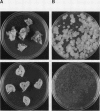Abstract
DNA coding for the enzymatically active subunit A of diphtheria toxin was placed under the control of the cauliflower mosaic virus 35S promoter and the Agrobacterium left transfer-DNA gene 7 polyadenylation signal. Agrobacteria carrying a binary plant vector with the chimeric diphtheria toxin A gene had very low transforming activity in tobacco (Nicotiana tabacum L.), and greatly diminished the recovery of stable transformants when mixed together with agrobacteria which alone transformed plant cells well. The introduction of this chimeric molecule into tobacco cells by electroporation lowered the level of the transient expression of the coelectroporated chloramphenicol acetyltransferase reporter gene indicating that expression of diphtheria toxin chain A in plant cells is toxic. We have developed a binary vector pGA987 which can be used for probing a variety of plant promoters.
Full text
PDF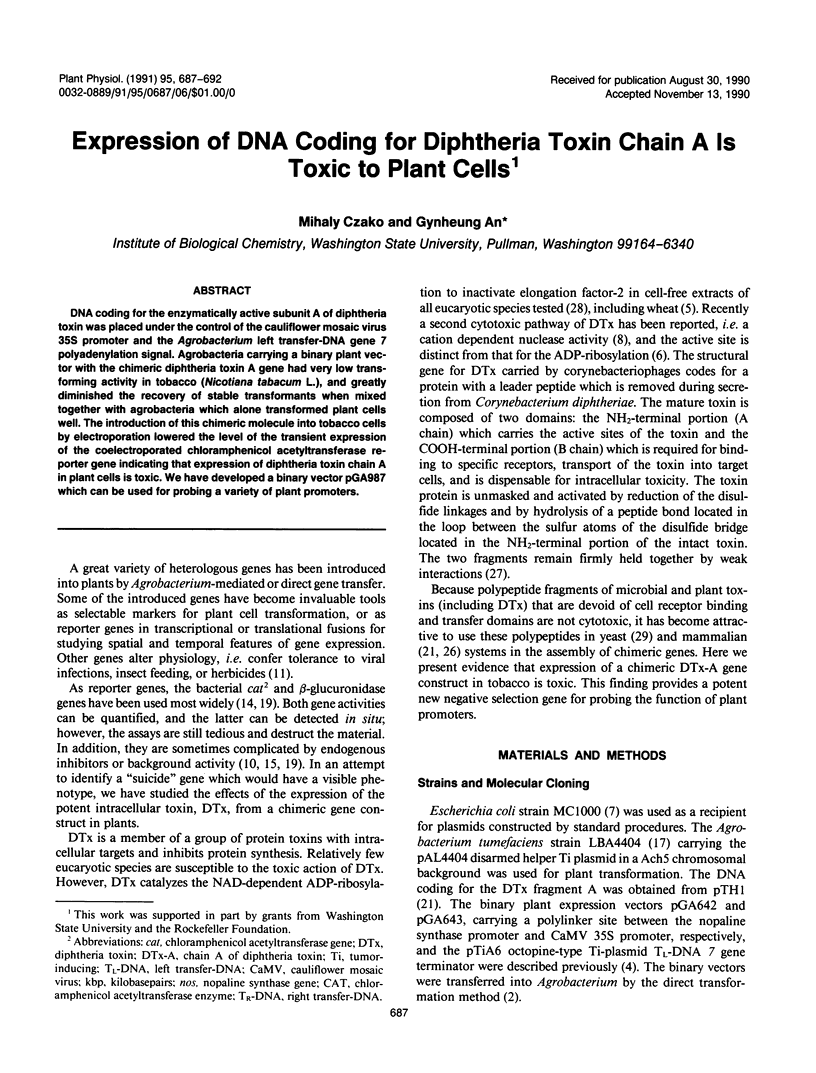
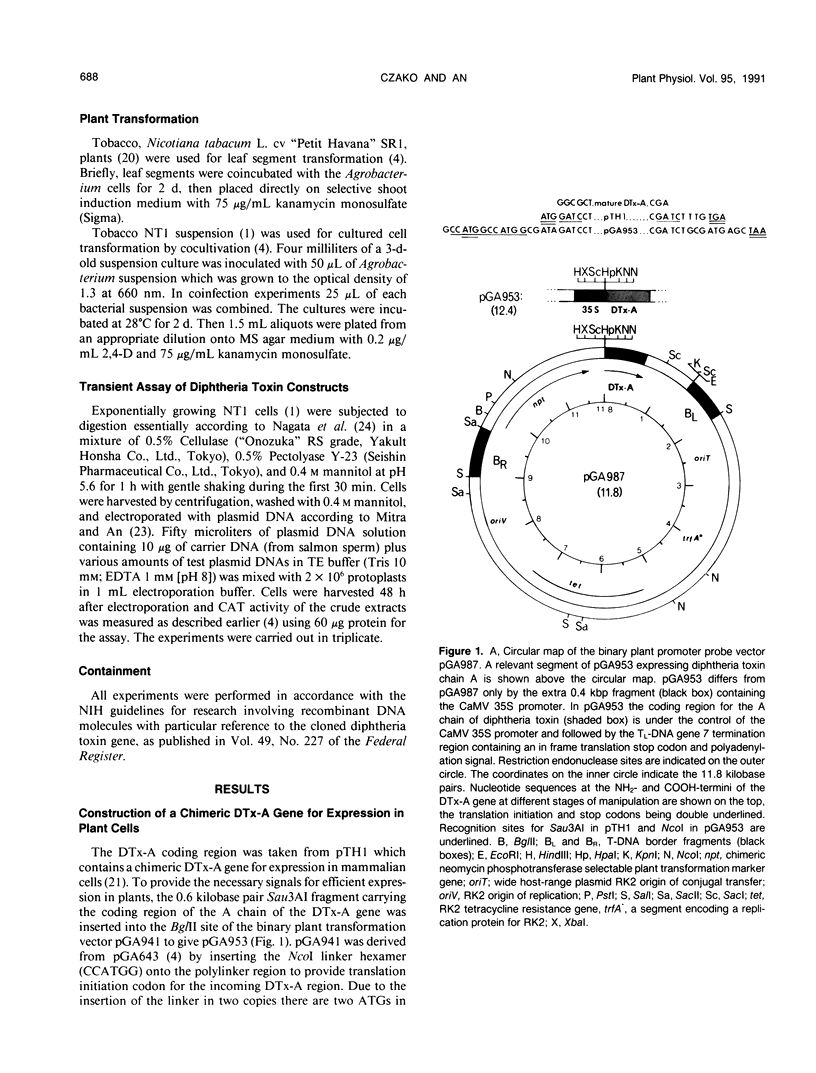
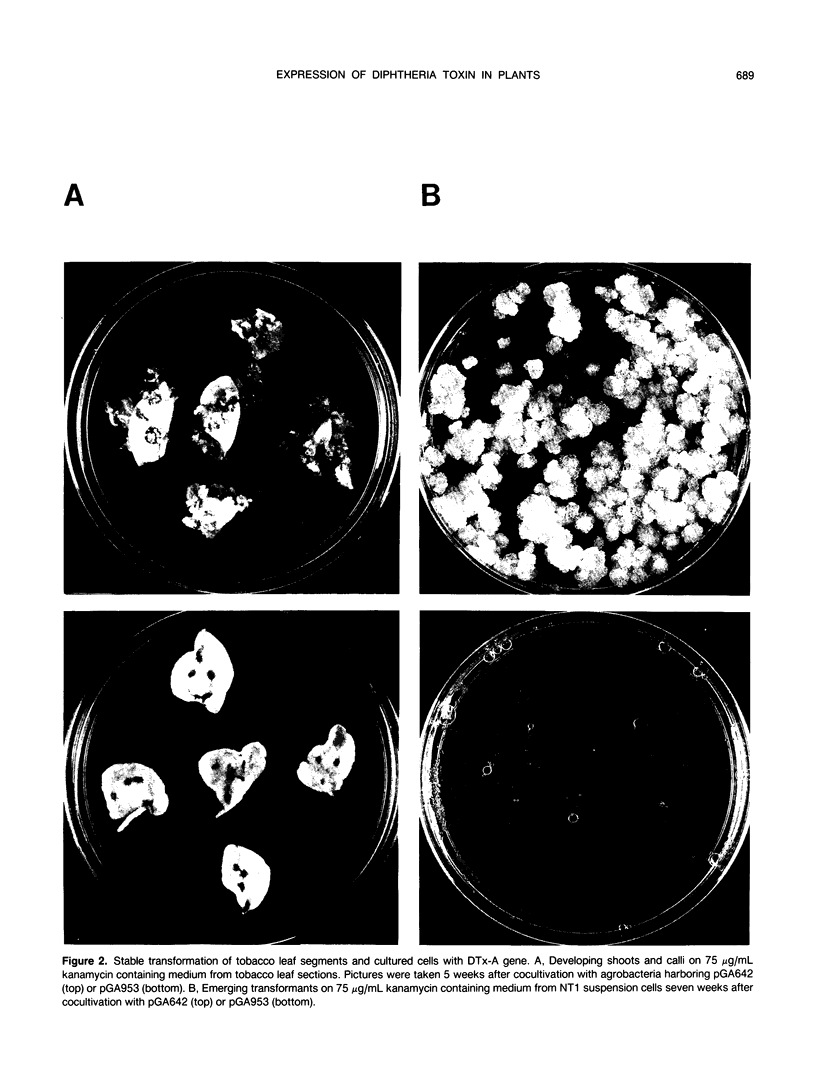
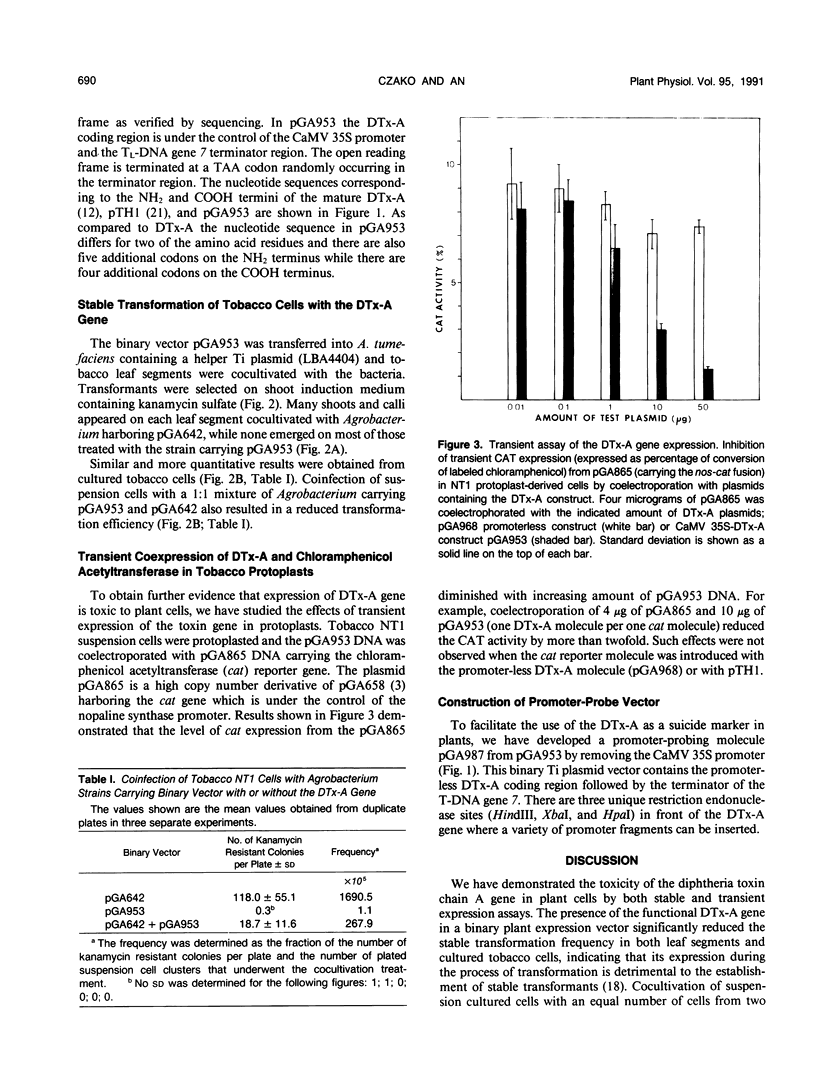
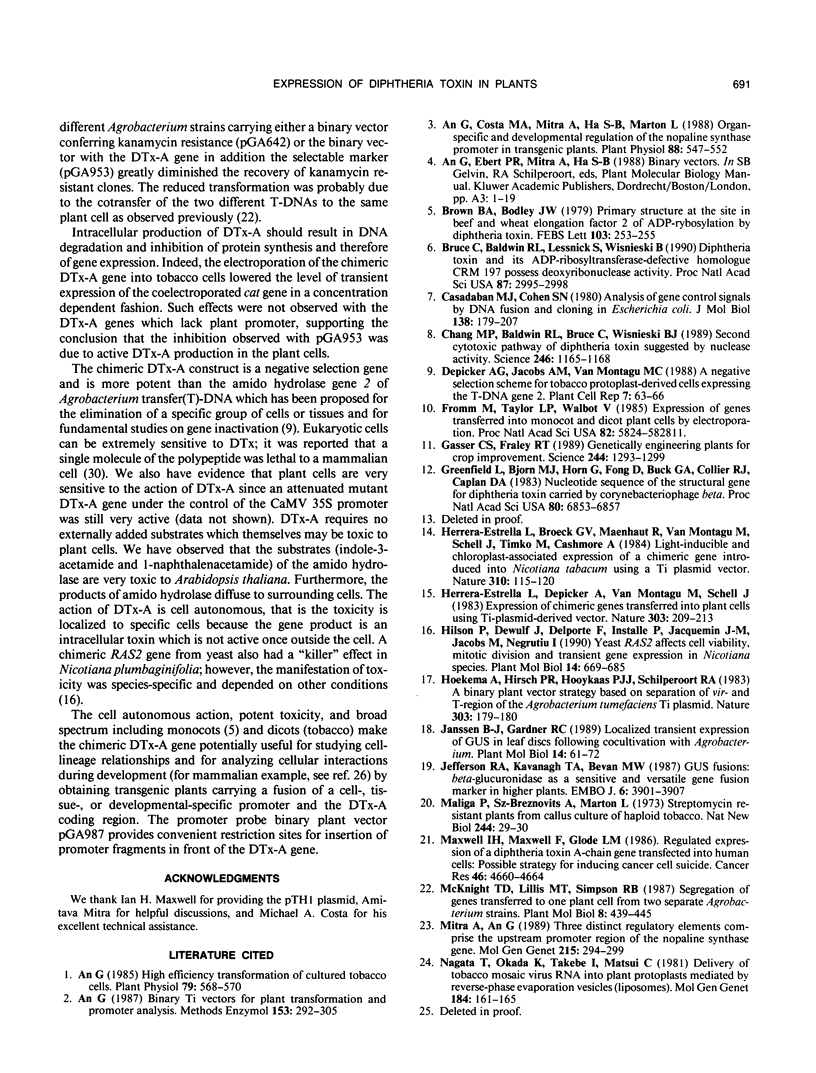
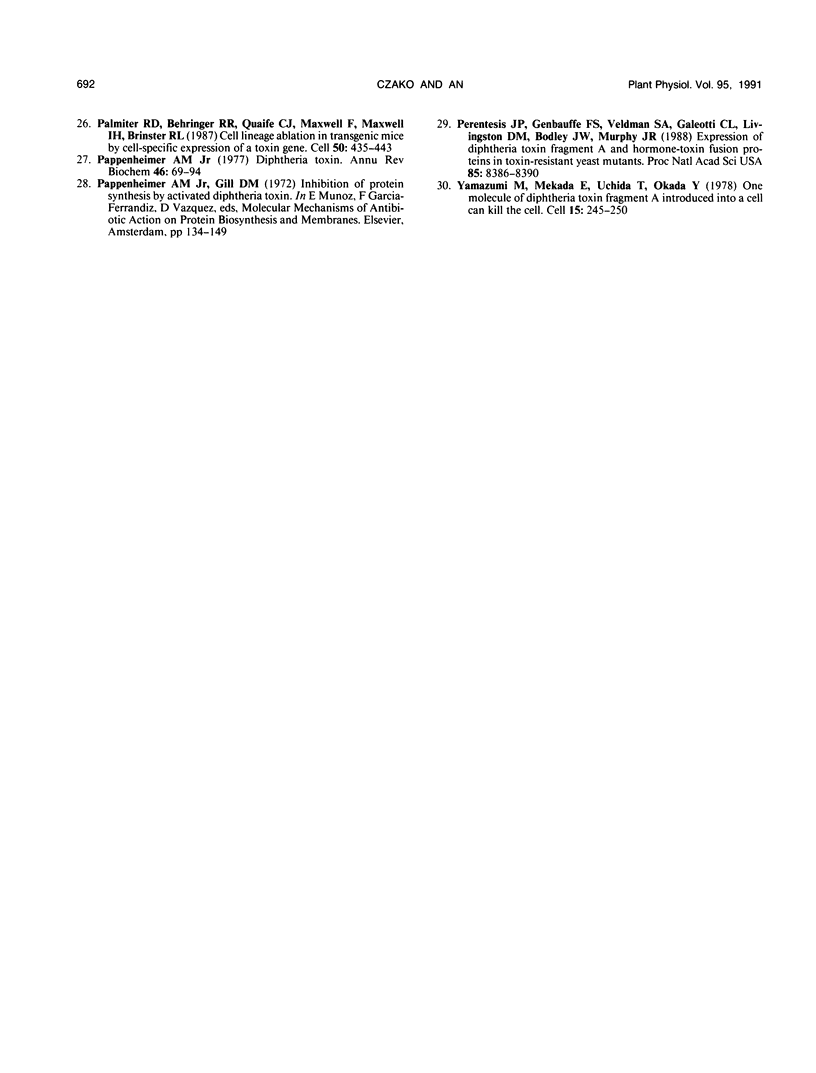
Images in this article
Selected References
These references are in PubMed. This may not be the complete list of references from this article.
- An G., Costa M. A., Mitra A., Ha S. B., Márton L. Organ-specific and developmental regulation of the nopaline synthase promoter in transgenic tobacco plants. Plant Physiol. 1988 Nov;88(3):547–552. doi: 10.1104/pp.88.3.547. [DOI] [PMC free article] [PubMed] [Google Scholar]
- An G. High efficiency transformation of cultured tobacco cells. Plant Physiol. 1985 Oct;79(2):568–570. doi: 10.1104/pp.79.2.568. [DOI] [PMC free article] [PubMed] [Google Scholar]
- Brown B. A., Bodley J. W. Primary structure at the site in beef and wheat elongation factor 2 of ADP-ribosylation by diphtheria toxin. FEBS Lett. 1979 Jul 15;103(2):253–255. doi: 10.1016/0014-5793(79)81339-3. [DOI] [PubMed] [Google Scholar]
- Bruce C., Baldwin R. L., Lessnick S. L., Wisnieski B. J. Diphtheria toxin and its ADP-ribosyltransferase-defective homologue CRM197 possess deoxyribonuclease activity. Proc Natl Acad Sci U S A. 1990 Apr;87(8):2995–2998. doi: 10.1073/pnas.87.8.2995. [DOI] [PMC free article] [PubMed] [Google Scholar]
- Casadaban M. J., Cohen S. N. Analysis of gene control signals by DNA fusion and cloning in Escherichia coli. J Mol Biol. 1980 Apr;138(2):179–207. doi: 10.1016/0022-2836(80)90283-1. [DOI] [PubMed] [Google Scholar]
- Chang M. P., Baldwin R. L., Bruce C., Wisnieski B. J. Second cytotoxic pathway of diphtheria toxin suggested by nuclease activity. Science. 1989 Dec 1;246(4934):1165–1168. doi: 10.1126/science.2531465. [DOI] [PubMed] [Google Scholar]
- Fromm M., Taylor L. P., Walbot V. Expression of genes transferred into monocot and dicot plant cells by electroporation. Proc Natl Acad Sci U S A. 1985 Sep;82(17):5824–5828. doi: 10.1073/pnas.82.17.5824. [DOI] [PMC free article] [PubMed] [Google Scholar]
- Gasser C. S., Fraley R. T. Genetically engineering plants for crop improvement. Science. 1989 Jun 16;244(4910):1293–1299. doi: 10.1126/science.244.4910.1293. [DOI] [PubMed] [Google Scholar]
- Greenfield L., Bjorn M. J., Horn G., Fong D., Buck G. A., Collier R. J., Kaplan D. A. Nucleotide sequence of the structural gene for diphtheria toxin carried by corynebacteriophage beta. Proc Natl Acad Sci U S A. 1983 Nov;80(22):6853–6857. doi: 10.1073/pnas.80.22.6853. [DOI] [PMC free article] [PubMed] [Google Scholar]
- Herrera-Estrella L., Van den Broeck G., Maenhaut R., Van Montagu M., Schell J., Timko M., Cashmore A. Light-inducible and chloroplast-associated expression of a chimaeric gene introduced into Nicotiana tabacum using a Ti plasmid vector. Nature. 1984 Jul 12;310(5973):115–120. doi: 10.1038/310115a0. [DOI] [PubMed] [Google Scholar]
- Hilson P., Dewulf J., Delporte F., Installé P., Jacquemin J. M., Jacobs M., Negrutiu I. Yeast RAS2 affects cell viability, mitotic division and transient gene expression in Nicotiana species. Plant Mol Biol. 1990 May;14(5):669–685. doi: 10.1007/BF00016500. [DOI] [PubMed] [Google Scholar]
- Janssen B. J., Gardner R. C. Localized transient expression of GUS in leaf discs following cocultivation with Agrobacterium. Plant Mol Biol. 1990 Jan;14(1):61–72. doi: 10.1007/BF00015655. [DOI] [PubMed] [Google Scholar]
- Jefferson R. A., Kavanagh T. A., Bevan M. W. GUS fusions: beta-glucuronidase as a sensitive and versatile gene fusion marker in higher plants. EMBO J. 1987 Dec 20;6(13):3901–3907. doi: 10.1002/j.1460-2075.1987.tb02730.x. [DOI] [PMC free article] [PubMed] [Google Scholar]
- Maliga P., Sz-Breznovits A., Márton L. Streptomycin-resistant plants from callus culture of haploid tobacco. Nat New Biol. 1973 Jul 4;244(131):29–30. doi: 10.1038/newbio244029a0. [DOI] [PubMed] [Google Scholar]
- Maxwell I. H., Maxwell F., Glode L. M. Regulated expression of a diphtheria toxin A-chain gene transfected into human cells: possible strategy for inducing cancer cell suicide. Cancer Res. 1986 Sep;46(9):4660–4664. [PubMed] [Google Scholar]
- Mitra A., An G. Three distinct regulatory elements comprise the upstream promoter region of the nopaline synthase gene. Mol Gen Genet. 1989 Jan;215(2):294–299. doi: 10.1007/BF00339731. [DOI] [PubMed] [Google Scholar]
- Palmiter R. D., Behringer R. R., Quaife C. J., Maxwell F., Maxwell I. H., Brinster R. L. Cell lineage ablation in transgenic mice by cell-specific expression of a toxin gene. Cell. 1987 Jul 31;50(3):435–443. doi: 10.1016/0092-8674(87)90497-1. [DOI] [PubMed] [Google Scholar]
- Pappenheimer A. M., Jr Diphtheria toxin. Annu Rev Biochem. 1977;46:69–94. doi: 10.1146/annurev.bi.46.070177.000441. [DOI] [PubMed] [Google Scholar]
- Perentesis J. P., Genbauffe F. S., Veldman S. A., Galeotti C. L., Livingston D. M., Bodley J. W., Murphy J. R. Expression of diphtheria toxin fragment A and hormone-toxin fusion proteins in toxin-resistant yeast mutants. Proc Natl Acad Sci U S A. 1988 Nov;85(22):8386–8390. doi: 10.1073/pnas.85.22.8386. [DOI] [PMC free article] [PubMed] [Google Scholar]
- Yamaizumi M., Mekada E., Uchida T., Okada Y. One molecule of diphtheria toxin fragment A introduced into a cell can kill the cell. Cell. 1978 Sep;15(1):245–250. doi: 10.1016/0092-8674(78)90099-5. [DOI] [PubMed] [Google Scholar]



